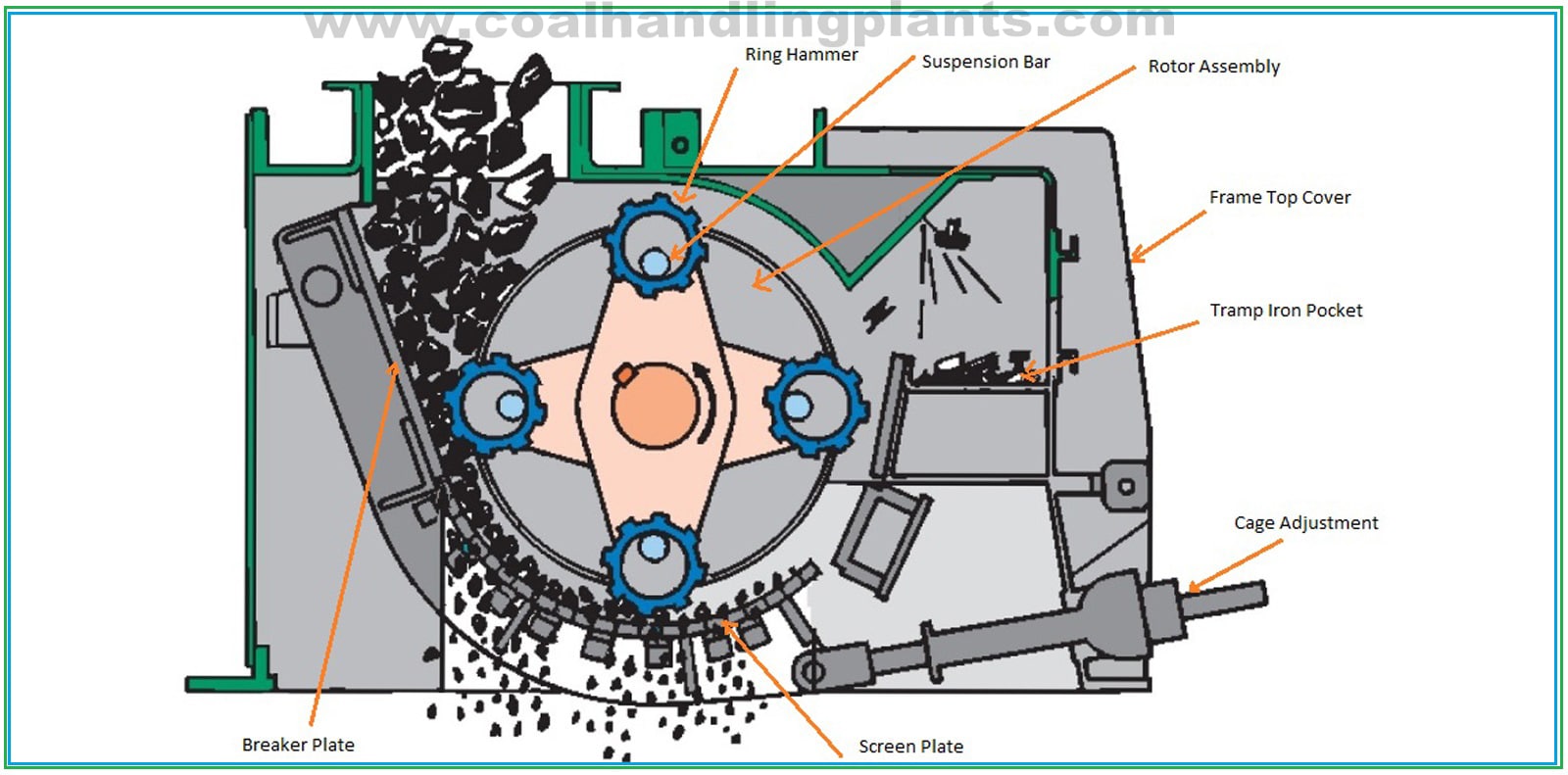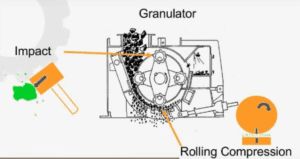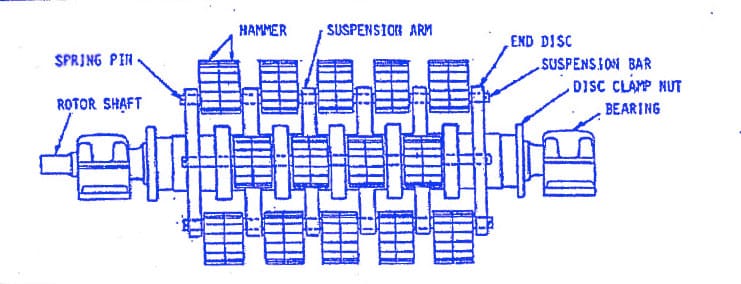[do_widget id=ai_widget-9]
Ring Granulator type crusher are used in coal handling plant for crushing coal to a size suitable at power stations prior to pulverization.
Crushing Principle Of Ring Granulator Type Coal Crusher

Ring Granulator crush material by a combination of impact and rolling compression.
The crushing action is performed when material is dropped through the feed opening where it is struck, in mid air by the multiple rings which are being driven round by the rotor discs in direction towards the breaker plate. The rings are mounted on suspension bars as shown in the diagram. When the rotor is set in the motion centrifugal force brings the ring out against material to be crushed.
[do_widget id=ai_widget-10]
As material is fed to the machine the rings are forced back towards the rotor center until bar is encountered by the ring internal surface and a forward driving force is exerted. The material is broken and discharged through the cage bars or screen plates thus easing the load and allowing the ring to move out until it is held again by suspension bar before encountering the incoming feed once again.
The rings are thus held in deep contact with the bed of material on the cage bars or screen plates and they revolve with planet like motion relative to the direction of rotor rotation. This positive rolling feature provides a constant effective crushing action which in turn ensures a granular product sizing. The size of crushed coal is determined by size of hole in screen plate and clearance
Single tooth rings or plain rings or double tooth or a mixture of both are used to meet the particular crushing condition required and the ring granulator type crusher are the ideal machines for the minimum fines production.
[do_widget id=ai_widget-11]
Ring Granulator Type Coal Crusher Consist Of Following Parts:
1. Frame
Crusher frame are fabricated from heavy steel plates with large inspection front and rear doors, fitted with dust tight seals. Access for further maintenance is provided on the top. Doors on the sides above the rotor shaft facilitate removal of the rotor without completely dismantling the machine. Hydraulic door opening arrangement (optional) can be provided, if required.
2. Rotor Assembly
Rotor assembly of crusher are statically/dynamically balanced to operate with minimum of vibration and noise. It consists of rotor shaft, end disc, arm, suspended bars, ring hammer and bearing sets.
Rotor Shaft – They are made of Forged and heat treated alloy steel.
Ring Hammer – They are made of Heavy cast Mn-steel toothed and/or plain Crushing Rings depending upon applications.
Bearing – Heavy duty double row spherical roller bearings with cast steel split type bearing housings with labyrinth type seals are used.
3. Cage Frame
They are fabricated from heavy steel plate and supported from heavy hinged cage shaft at top and provided with adjusting mechanism at the bottom.
4. Cage Adjustment
Cage adjustment are require to adjust clearance between the cage screen and path of ring hammer. the Cage assembly can be easily moved by a ratchet wrench and worm gear assembly either towards or away from the
path of crushing rings. Adjustment which can be made while the granulator is in operation, provides control over the product size within permissible limits. The cage hinge bearing is so located that in any adjusted position all parts of cage face are practically equidistant from the rotor assembly. This ensures even wear.
5. Cage Bars or Screen Plate
The size of hole in screen plates has been selected as per requirement of coal size require prior to pulverization. Screen plates are made from abrasion resistant steel.
6. Breaker Plate
They are made of Replaceable abrasion resistant steel. The main function of breaker plate is to protect the crusher body from wear.
7. Tramp Iron Pocket
Tramp iron and uncrushables are prevented from continuing around and back into the crushing zone by a heavy metal plate. The debris is collected in a pocket and removed from access door.
Work Involved During Preventive Maintenance Of Ring Granulator Type Coal Crusher
[do_widget id=ai_widget-12]
During preventive maintenance of ring granulator type crusher following equipments/parts are checked and detected problems are corrected.
1. Rotor Assembly

The granulator rotor assembly generally require minimum maintenance with the exception of hammer and suspension bar replacement. Frequency of hammer and suspension bar replacement will depend upon the material crushed and the rate it is fed. Preventive maintenance of rotor assembly include the following:
- Check wear on hammers and suspension bars.
- Check disc clamp nuts for tightness. If not tight, suspension arms will loosen and cause wear on the rotor key, rotor shaft and suspension arm bore. In addition, vibration may occur.
- Check suspension bar holes in suspension arms for any elongation. After a long period of service, this is likely to occur.
- Check The suspension bar ends for wear which may also occur during the wearing period of set of hammers.
- Check End disc proper tightness & should not be any wear & tear.
- Check any erosion on blade arm and hard facing condition.
2. Kick off plates – Check proper tightness, any wear & tear.
3. Liners – Check proper tightness, any wear & tear.
4. Breaker Plate– Check for proper tightness & any wear & tear.
5. Screen Plate – Check proper tightness, any wear & tear.
6. Hydraulic System – Check for oil leakages, oil level, oil condition, cleanness.
7. Casing Bolt – Check bolts tightness with washer.
8. Receiving chute sealing (Bellow) – Check during operation no dust leakage from the discharge chute. Bellow all bolts should be proper tight.
9. Discharge Chute – Check inside condition of chute. Cleaning should be done if required.
10. NDE and DE Bearing
- Bearing greasing in regular interval of time.
- Check bearing clearance, grease quality & labyrinth seal condition.
11. Coupling – Check condition of all coupling.
12. Gear Box – Check for oil leakages, oil level, oil condition and cleanness.
13. Bolts – Check proper tightening of all bolts.
RELATED SEARCHES:
[do_widget id=ai_widget-13]
